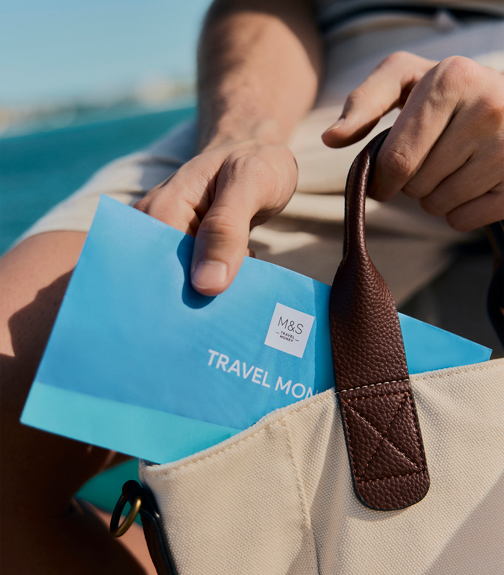How to order Polish Zloty
-
Order your Polish Zloty online with our currency Click & Collect service. Choose your collection date and pick up from your selected M&S store’s bureau de change.
Click & Collect PLN in as little as 60 seconds*.
*Subject to availability.
-
Or visit a participating M&S store to buy Polish Zloty. With stores nationwide - many open seven days a week and late into the evening - you can buy your Travel Money at a time that suits you.

Why buy Polish Zloty from M&S Travel Money?
Get your trip to Poland off to a great start with quick and easy currency exchanges. With M&S Travel Money, you can expect:
- Stores open 7 days a week.**
- A choice of collection options.
- Over 50 currencies avaliable in selected stores.
**Store opening hours vary.

What you need to know about the Polish Zloty currency
The Polish Zloty is the official and legal tender of Poland. The currency comes in both coins and banknotes.
Coins include:
1 gr, 2 gr, 5 gr, 10 gr, 20 gr, 50 gr, 1 zł, 2 zł, 5 zł
Banknotes include:
10 zł, 20 zł, 50 zł, 100 zł, 200 zł, 19 zł, 500 zł
You can buy Polish Zloty online using our Click & Collect service.
^^Please note not all denominations are available to exchange.

Guide to Poland
In the heart of central Europe, Poland is a country that offers something for everyone.
Known for its rich, unique history steeped in centuries of tradition, Poland is home to delicious food, beautiful architecture, and fantastical folklore rooted in Slavic heritage.
Whether you’re interested in exploring the great outdoors, wandering through cobbled city streets or seeking out the hottest nightlife, Poland is an affordable destination where your Zloty can go a long way.
Frequently asked questions
Using debit and credit cards for payments is accepted in most areas of Poland. Remember to pay in the local currency if you do use your card, as paying in GBP can potentially cost you more (depending on the exchange rate). Having some Polish Zloty on hand for smaller purchases is also a good idea, both for tipping and situations where card payments aren’t possible.
Poland is known as a budget-friendly destination. The cost of a basic meal in a restaurant typically ranges from 26 to 60 PLN (around £5 to £12).
Poland’s official currency is the Polish Złoty, and it’s the primary legal tender used throughout the country. euros and US dollars may be accepted in some major tourist areas or by some businesses, but this shouldn’t be relied upon.
If you’re heading to Poland for a holiday, you won’t need a visa. UK citizens can stay for up to 90 days in a 180-day period, but if you want to stay longer or earn some money, you’ll need to apply for the appropriate visa or work permit. You should always research the most up-to-date visa guidelines before planning a trip.
Poland follows Schengen area rules, meaning your passport must be valid for at least three months beyond the date you depart the Schengen area.
Other passport holders should check the entry requirements with your country’s embassy.
Tipping in Poland isn’t mandatory. Most service workers consider tips a nice bonus, but won’t usually be offended if you decide not to leave one.
If you want to leave a tip, the most common practice is to tip 10% of the bill. In some more upscale locations, the tip might be closer to 15-20%. If you’re drinking in a bar, you can leave a tip or round up the bill each time you order a beverage.
Polish is the official language of Poland and is spoken by the vast majority of the population. However, several other languages are spoken by select groups, including:
- Silesian
- Kashubian
- German
- Belarusian
- Ukrainian
- Romani
- Rusyn
- Lithuanian
Poland is generally a safe country to visit, though it’s always wise to check and follow government travel advisories before planning your trip.
You can also visit the Foreign, Commonwealth & Development Office (FCDO) for the latest government travel advice for Poland.
There’s no single best time to visit Poland; it largely depends on your interests. Summer (June to August) is the peak tourist season and usually sees warm weather, ideal for exploring cities and enjoying outdoor activities. Winter (December to February) is also popular, especially for Poland’s renowned Christmas markets and winter sports facilities.
It’s a good idea to buy your Polish Zloty before you get to Poland. This helps you secure better rates and avoid hidden fees, plus it means you don’t have to waste your holiday time searching for somewhere to exchange your currency. Don't exchange currency at the airport, as the exchange rates can be poorer compared to those online or on the high street.
Yes, you can make contactless payments in Poland, but as with all card payments made abroad, you risk foreign transaction fees and unfavourable exchange rates.
You can only spend Polish Zloty in Poland, where it's the official currency.
Other popular currencies
If you are planning a future holiday or a trip that takes in multiple destinations, these other currencies may be useful:


